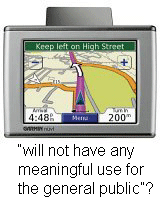 In 1987, the few dozen GPS models available were mostly larger than 200 cu in and cost $15,000 to $45,000. (https://adsabs.harvard.edu/abs/1988inna.meet..158C) Today there are thousands of models, many for under $100, and GPS technology is cheap enough and small enough to be a commonplace add-on to cell phones and PDAs. At the start, few could have recognized how ubiquitous GPS technology would be. It is now difficult to find paper road maps.
In 1987, the few dozen GPS models available were mostly larger than 200 cu in and cost $15,000 to $45,000. (https://adsabs.harvard.edu/abs/1988inna.meet..158C) Today there are thousands of models, many for under $100, and GPS technology is cheap enough and small enough to be a commonplace add-on to cell phones and PDAs. At the start, few could have recognized how ubiquitous GPS technology would be. It is now difficult to find paper road maps.
In current Systematic Biology 55:844 (not open access so no article link here), three worried taxonomists opine that DNA barcoding won’t work because it’s too expensive. This is likely incorrect. Any process involving electronics and/or chemicals is likely to become faster, cheaper, and smaller, perhaps dramatically so. Just as with GPS, lowered costs increase use, and increased use helps lower costs. On the DNA front, researchers are developing microfluidic grapefruit-sized sequencers that analyze sub-femtomole quantities of DNA in nanoliter volumes, with proportionally reduced reagents costs. Alternative technologies such as pyrosequencing may be even faster and cheaper.
No one can predict the course or speed of technology development, but betting against technology is short-sighted. The authors Cameron, Rubinoff, and Will do allow that a database of 10 million species might be assembled for about $0.5 billion dollars, which would be “much cheaper than other “big science” initiatives”. Not content, they decide that 10-fold more specimens and 3-fold more genes will be needed and presto, the cost is $15 billion!
I believe the costs of assembling the database and of routine applications will be lower than they estimate. In addition, the database will be widely used long before it is “complete”. Looking ahead, taxonomists need to make more clear the scientific and practical value of cataloging, whether by traditional means or DNA-led discovery, the estimated millions of as yet undescribed species, most of which are thought to be insects in tropical regions.
Where will the money come from? The authors worry about effects of the Barcode of Life Initiative on current taxonomy, but their own calculations show there is no need for concern. There simply is not enough money in traditional taxonomy, which they estimate has global support of $10 million/year. To my knowledge all funding for barcoding work so far has come from sources that do not support traditional taxonomy. The situation is similar to the Human Genome Project, which worried many biomedical researchers who feared it would consume all their resources. Partly as a result, the HGP was not funded by National Insitutes of Health or National Science Foundation, but by the Department of Energy. The Barcode Initiative will help establish Environmental Genomics as a field of science, will open up new sources of support to do so, and will not subtract from traditional taxonomy.